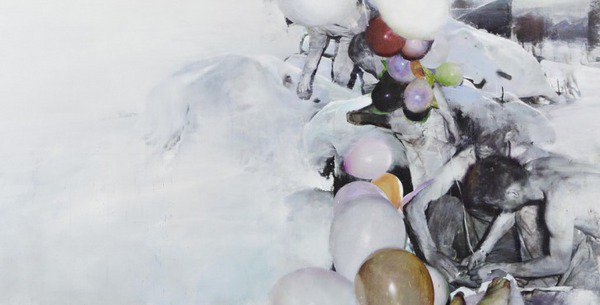Justin Mortimer
dal 11/10/2012 al 23/11/2012
Segnalato da
11/10/2012
Justin Mortimer
Haunch of Venison, London
Resort. The exhibition presents 12 new oil paintings - including 5 large-scale works - that showcase the artist's facility as a figurative painter and his signature multi-dimensional environments.

Haunch of Venison presents its first solo exhibition with British painter Justin Mortimer. Justin Mortimer’s exhibition, Resort, presents twelve new oil paintings - including five large-scale works - that showcase the artist’s facility as a figurative painter and his signature multi-dimensional environments.
These pictures are characterized by depictions of the human figure isolated in landscapes or interior chambers and surrounded by medical apparatus, machinery and in several works, acid coloured balloons which hover around the anonymous figures. While the specific subject or location of the paintings remains mysterious, they suggest an underworld of clandestine operations and suspicious intent.
In the title work, Resort, a group of malnourished soldiers form a diagonal line across a snowy landscape. Two of them appear to be treating a wounded arm while others scavenge behind. The view is obscured by balloons, which block off the heads and limbs of the figures, and positioned in the background is a sinister triangular building. Each element of the work is represented realistically but the viewer’s reading of the narrative is complicated by the unnatural combination of photo-realist black and white figures with sickly colour and the association of war with party balloons.
The multi-layered nature of Mortimer’s pictures is partly achieved by his use of collage. Before starting to paint, he creates a composite image on Photoshop, which includes jpegs downloaded from the Internet, scans from historical documents and medical textbooks as well as his own photographs. This collage, which can be adapted several times once the painting has begun, is used as a reference for the subject and composition of the final work.
While Mortimer began his career making realist portraits he has since developed a body of work that focuses on the physical and psychological effects of war and surgery but eschews literal interpretation. The collage process, through its use of digital imagery, warped perspectives, subject matter and an intense palette of blacks, yellows, greens and mauves, places his paintings somewhere between reality and the subconscious. The scenes in Chamber, Crèche, Kraal and Perimeter are marked by their partial evidence: figures stalk dark landscapes and rooms, their bodies cut-off and various instruments put to dubious use. Tapping into collective fears and anxieties, the paintings hint at a violence or physical discomfort that may or may not have taken place in reality.
Several smaller paintings emphasise this abstract unease. Evidence I and II depict chocolate wrappers torn in such a way that they resemble shrapnel and the insistent strangeness and beauty of a work like HN-1 is seductive because it refuses to be simply a stack of polystyrene. In Hygiene a boy is shown naked from the torso up standing against a green wall with an ominous shadow beside him while the Donor series features tightly cropped heads of men with facial disfigurements.
Who these subjects are and what exactly has happened to them remains beyond the viewer’s grasp but they captivate a human fascination with wrongdoing and depravity. Mortimer’s use of familiar motifs within his paintings root them partially in reality but their inexplicable presentation and mystical atmosphere is one of dreams and nightmares.
Haunch of Venison
51 Eastcastle Street London W1W 8EB
Hours: Mon- Fri 10:00 - 18:00



